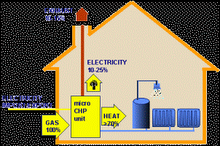Microgeneration can make a significant contribution to the overall energy system, particularly as a complementary component supporting other energy sources. In the book on micro CHP the potential to optimise this interaction is discussed, pointing out the risk that ill-considered government interventions, well-meaning, but ill-advised, may result in very poorly optimised systems. As an example the FIT (Feed In Tariff) as a consequence of the quite extreme distortion of value to the microgenerator, may result in a decade of sub-optimal control of microgeneration systems.
More detailed discussion is provided in the book, but in summary the point is made that, if the FIT is set at a level significantly higher than the true value of electricity produced (which it clearly is with PV at 41.3p/kWh against a retail value of around 10p/kWh and an export value of 3p/kWh), there is no incentive for the generator to match generation to self consumption. Only when this distorting subsidy is modified will anyone make the least effort to increase self-utilisation of generation output; we all suffer as a consequence.
At Intersolar, the European solar jamboree, one company (IBC Solar) was planning to introduce to the German market in September (when the German FIT will be significantly reduced) a rather clever system which is intended to realign consumption to generation by enabling certain circuits/appliances only when the PV (or other microgeneration system including micro CHP) is generating, thus improving self-consumption of generated electricity and consequently economic value to the consumer. At a cost of around €750 it is not cheap, but at least it proves the point, that developers will come up with better designed systems, but only once the distortions of FIT are withdrawn or at least reduced.
Anyway, another good reason to buy the book on micro CHP if you really want to understand microgeneration!
Thursday, 10 June 2010
Sub-optimal microgeneration...including micro CHP
Labels:
feed-in tariff,
FIT,
micro CHP,
micro CHP book,
microgeneration,
micropower
Subscribe to:
Post Comments (Atom)



No comments:
Post a Comment